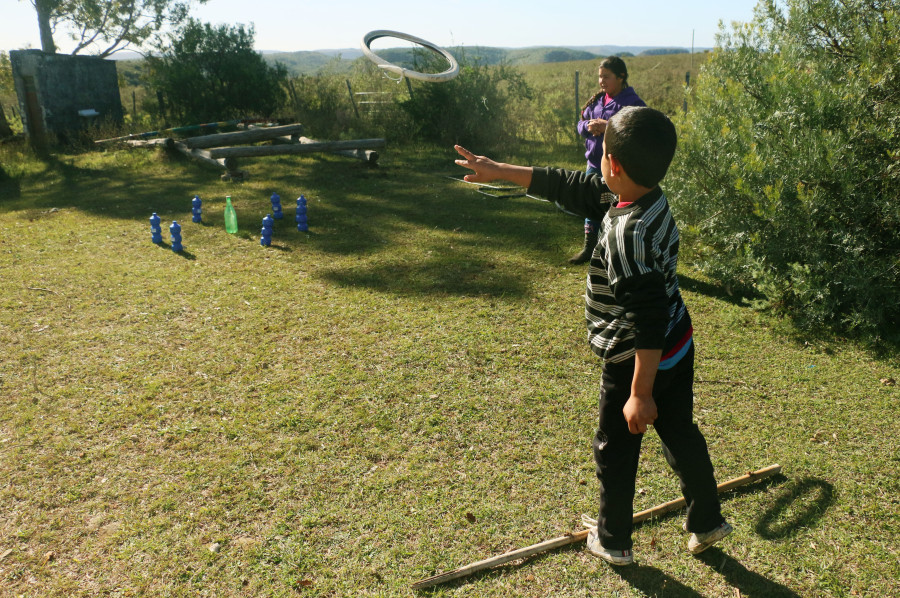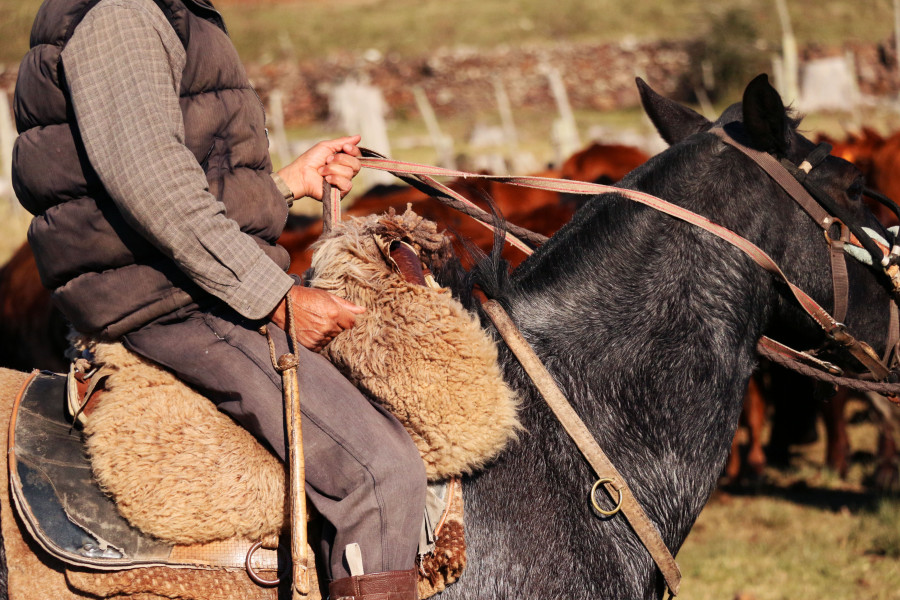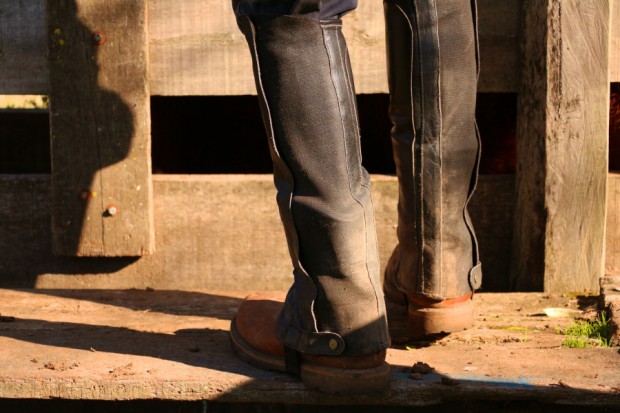FLORA HASTINGS asks Juan Morales about his hopes and fears for the traditional Uruguayan Gaucho lifestyle in the twenty-first century.
As a boy, Juan Morales rode two hours on horse back everyday to a one-room school-house overlooking acres of grassland. Gauchos like Juan – wearing ponchos, woollen berets, and traditional cotton trousers called ‘Bombachas de Campo’ – have been living amongst Uruguay’s grasslands, or Pampas, since cattle were first introduced there by the Spanish Major of Buenos Aires in 1630. When Juan went to school, he was taught in a class of thirty pupils, but four decades later there are only three. When I spoke to him last summer, he and his partner Suzanne were deciding if they were going to send their two daughters there instead of the local town’s boarding school – choosing between the quality of their daughters’ education and sustaining a school that allows the children of neighbouring gauchos to remain at home. Gauchos now figure less than three per cent of the population of Uruguay, and without a growth in rural workers there is little government incentive to extend amenities to the most isolated parts of the North. As Juan identifies, this move would not only connect gauchos to the modern world, ensuring the survival of their historic lifestyle, but also alleviate the problems found in Uruguay’s city slums.

Juan refers to all tourists as city slickers, laughing in their faces when telling them that the estancia’s generators provide only two hours of electricity per day. Juan, however, is not a typical gaucho: ‘I am lucky’, he says’ ‘I have a generator and a fridge’. He also treks up Machu Picchu each June, has travelled on horseback across Argentina and he met his Swiss-German partner Suzanne in Tibet when he was twenty. Concerned that the traditions of Gaucho life are retreating in the face of urbanisation and the exodus of rural workers from the countryside, Juan and Suzanne opened their estancia for travellers willing to work fifteen years ago. ‘I just complain about the Gauchos that live in the darkness’ he says, ‘I am speaking for the Gauchos that do not have a voice.’
The Gaucho lifestyle today is ‘so hard and tough and demanding, that there is not a place for resentment’ – or advocating political change. Historically, gauchos have been mythologised as nomadic, isolated figures. Emigrants from Europe were needed to manage the introduction of cattle, and the majority of gauchos at the outset were Spanish or Italian settlers. Gauchos were enlisted by warring colonialist militias in the bloody battles between European countries over ownership of the fertile land. In times of peace they rode between large estancias to work for a season, cultivating their national image as skilled equestrian herdsmen. In the early nineteenth century, figures like José Artigas, whose painting hangs in the public school Juan attended, channelled popular discontent towards the colonialists. Artigas, known as the ‘father of Uruguay’s nationhood’, ran away from a religious school aged twelve, acquired the vagabond nature of a gaucho illegally smuggling cattle and then became a military lieutenant who used tactics of guerrilla warfare to fight the Spanish royalists. Gauchos, originally fighting for colonist factions, cemented their national identity as fighters for Uruguayan independence.

Many gauchos today lead a lifestyle very similar to that of their original forbears. In the north of Uruguay in particular, they are left to work on estancias deserted by their owners during the week, the so-called ‘weekend gauchos’. The rural workers live with ‘candles and no running water and no decent roads and no mobile coverage’. Perhaps their extreme remoteness ‘is why there are Gauchos living in 2015’ because they have been ‘living like this for their whole life – they do not know any different’. However, Juan’s passionate respect for the traditional Gaucho way of life does lead him to disconnect from modern, urban Uruguay. Today, only five per cent of Uruguay’s population live in the countryside. Juan wants to ‘create a new mentality with programs that try to integrate the rural population with the urban one. In Uruguay the rural and urban population do not know each other – they are pulling in different directions’.
When asked if he thinks there would be a growth of new estancias if more of the countryside was electrified, Juan responded ‘Absolutely! We need people in the countryside, for God’s sake!’ He sees it as a tragic shame that despite Uruguay’s rural based economy it is so difficult to find workers, and states ‘people living on the favelas outskirts of Uruguayan cities are a “waste” of human resources, in a country with a chronic shortage of them’ – alluding to Uruguay’s population of under 3.5 million people. He sees rural work as a ‘huge step’ in the direction of resolving the pernicious problem of street-drug ‘pasta base’, a by-product of cocaine, in Uruguay’s cities.

With such a small population, as well as democratic electoral procedure not complicated by corruption, change can be wrought quickly in Uruguay. Indeed, Uruguay’s previous president José Mujica passed the experimental legalisation of marijuana to combat the problem of ‘pasta base’. Mujica, in a manner reminiscent of the gauchos of old, fought with left-wing urban guerrilla group Tupamaros in the sixties, robbing banks to give money to Montevideo’s poorest. You wouldn’t have seen him in the Legislative Palace wearing a three-piece suit because he donated ninety per cent of his monthly wage to charity. The new leftist president Tabaré Vázquez is radically developing Uruguay’s environmental footprint, and as of 2015, ninety-five per cent of the country’s energy is supplied by renewable sources.
Nonetheless, neither of these presidents has successfully identified the potential of the countryside in solving Uruguay’s problems. Juan hopes for the modernisation and expansion of rural work, even if this threatens the preservation of the traditional Gaucho lifestyle that he has grown up with. ‘The thing is you need to make a decision: Do you want, in the twenty-first century, to keep people living like they were in the nineteenth century, just for the sake of keeping a culture, or do you think people have the right to have internet, and electricity and a bloody phone and a fridge running in bloody summer?’ As he identifies, if Uruguay’s countryside remains disconnected and harshly remote ‘there will be a moment when there are no Gauchos at all, because no one, only very old people, will be living in the countryside’.
To Juan, the solution is simple: ‘if the government invested in resources to bring the slums of the cities into the countryside – than we would have a new Uruguay’.
All photographs were taken by the author, visit her website here.






